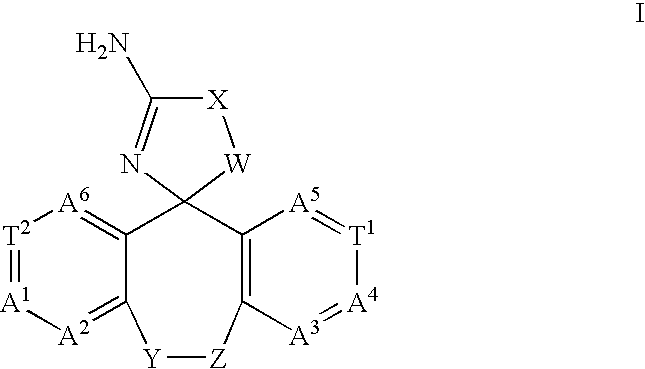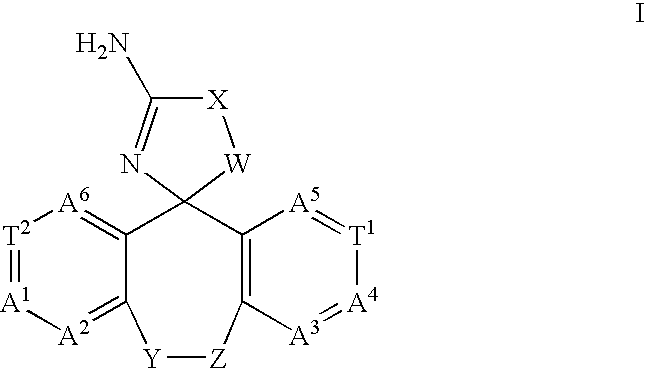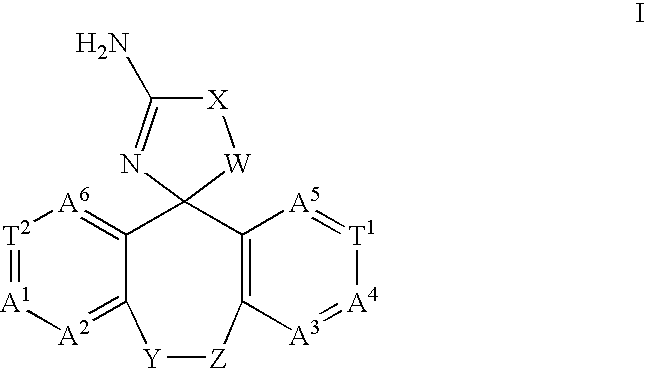Spiro-tricyclic ring compounds as beta-secretase modulators and methods of use
a tricyclic ring compound and beta-secretase technology, applied in the field of betasecretase-mediated diseases, can solve the problems of loss of cognitive function, diminished cognition of self, family and friends, and beta-secretase cleavage site thought to be a rate-limiting step in a-beta production
- Summary
- Abstract
- Description
- Claims
- Application Information
AI Technical Summary
Problems solved by technology
Method used
Image
Examples
example 1
[0527]
Synthesis of 2-Bromo-7-methoxy-9H-xanthen-9-one
Step 1: 2-(4-Bromophenoxy)-5-methoxybenzoic acid
[0528]4-Bromophenol (8.7 g, 50 mmol), Cs2CO3 (16 g, 50 mmol), CuOTftoluene complex (2:1) (0.625 mmol, 5 mol % Cu, 150 mg), ethyl acetate (0.25 ml, 2.5 mmol) were added to a solution of 2-bromo-5-methoxybenzoic acid (11.6 g, 50 mmol) in toluene (40 mL) in a sealed tube. The reaction mixture was purged with N2, and was heated to 110° C. until the aryl halide was consumed as determined by LC-MS (48 h). After cooling to rt, the mixture was filtered through a Celite plug. The Celite plug was washed with EtOAc. The mixture was acidified by 1N HCl, and extracted w / EtOAc. The combined organic phases were washed with brine, dried over anhydrous sodium sulfate, filtered, and concentrated. This residue was purified via column chromatography on silica gel (gradient elution with 0-10% MeOH / DCM) to afford 2-(4-bromophenoxy)-5-methoxybenzoic acid. MS m / z=324.9 [M+H]+. Calc'd for C14H11 BrO4: 323.1....
example 2
[0530]
Synthesis of 2′-Bromo-6′-methylspiro[1,3-oxazole-4,9′-xanthen]-2-amine
Step 1: 2-(4-Bromophenoxy)-4-methylbenzoic acid
[0531]4-Bromophenol (0.87 g, 5 mmol), Cs2CO3 (1.6 g, 5 mmol), CuOTf toluene complex (2:1) (0.0625 mmol, 5 mol % Cu, 33 mg), ethyl acetate (0.013 ml, 0.125 mmol) were added to a solution of 2-bromo-4-methylbenzoic acid (0.86 g, 5 mmol) in toluene (2 mL) in a sealed tube. The reaction mixture was purged with N2, and was heated to 110° C. until the aryl halide was consumed as determined by LC-MS (48 h). After cooling to rt, the mixture was filtered through a Celite plug. The Celite plug was washed with EtOAc. The mixture was acidified by 1N HCl, and extracted w / EtOAc. The combined organic phases were washed with brine, dried over anhydrous sodium sulfate, filtered, and concentrated. This residue was purified via column chromatography on silica gel (gradient elution with 0-10% MeOH / DCM) to afford 2-(4-bromophenoxy)-4-methylbenzoic acid, MS m / z=309.1 [M+H]+. Calc'd f...
example 3
[0536]
Synthesis of 2′-Hydroxy-7′-(5-pyrimidinyl)spiro[1,3-oxazole-4,9′-xanthen]-2-amine
Step 1: 2-Bromo-7-methoxy-9-methylene-9H-xanthene
[0537]A solution of 2-bromo-7-methoxy-9H-xanthen-9-one (2.035 g, 6.7 mmol) in THF (67 ml) contained in a 250-mL RBF was cooled in a dry ice / acetone bath for 10 min to give a milky-white mixture. Trimethylsilyl methyllithium (10 ml of a 1.0 M solution in pentane, 10 mmol) was added dropwise over 5 min to give a clear orange solution. The mixture was stirred for 15 min, then acetyl chloride (0.76 ml, 11 mmol) was added dropwise, resulting in the formation of a clear, bright-yellow solution. The mixture was warmed to RT for 3 h, then an additional portion of acetyl chloride (0.25 mL) was added. The mixture was stirred for an additional 30 min before being diluted with saturated aqueous sodium bicarbonate solution (100 mL). The biphasic mixture was extracted with EtOAc (2×50 mL), and the combined organic extracts were dried over sodium sulfate, filtered...
PUM
| Property | Measurement | Unit |
|---|---|---|
| Temperature | aaaaa | aaaaa |
| Temperature | aaaaa | aaaaa |
| Temperature | aaaaa | aaaaa |
Abstract
Description
Claims
Application Information
 Login to View More
Login to View More - R&D
- Intellectual Property
- Life Sciences
- Materials
- Tech Scout
- Unparalleled Data Quality
- Higher Quality Content
- 60% Fewer Hallucinations
Browse by: Latest US Patents, China's latest patents, Technical Efficacy Thesaurus, Application Domain, Technology Topic, Popular Technical Reports.
© 2025 PatSnap. All rights reserved.Legal|Privacy policy|Modern Slavery Act Transparency Statement|Sitemap|About US| Contact US: help@patsnap.com



